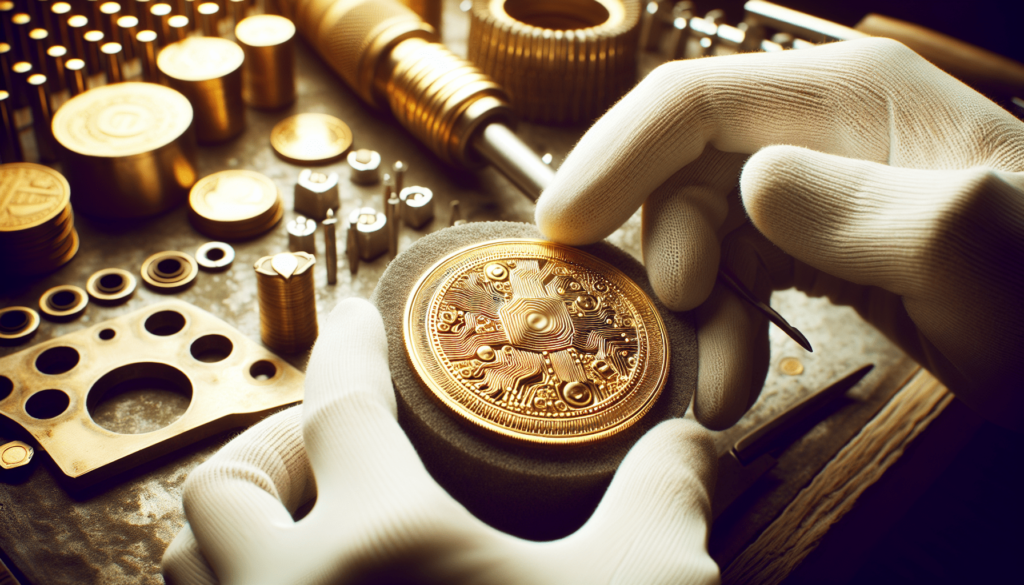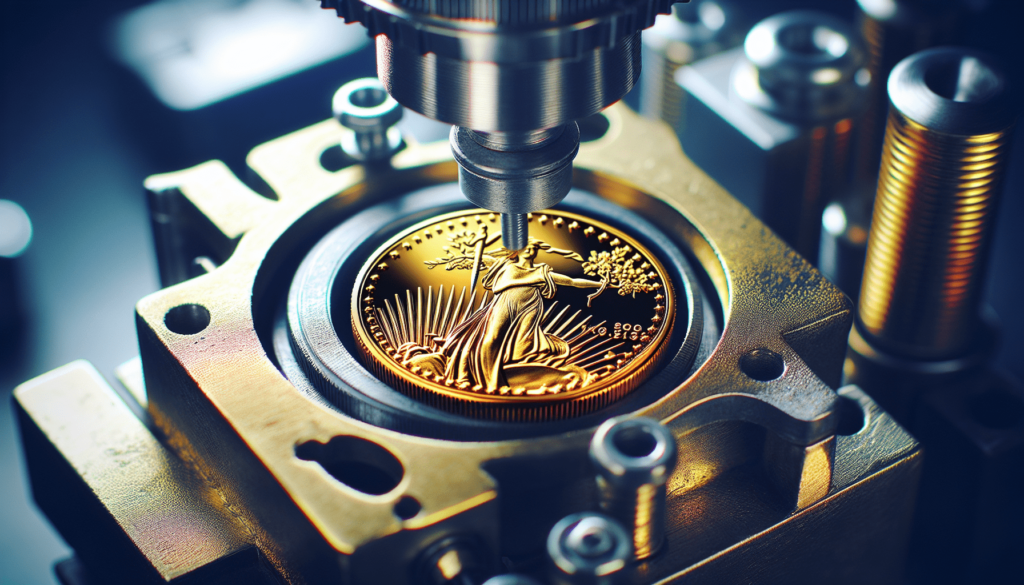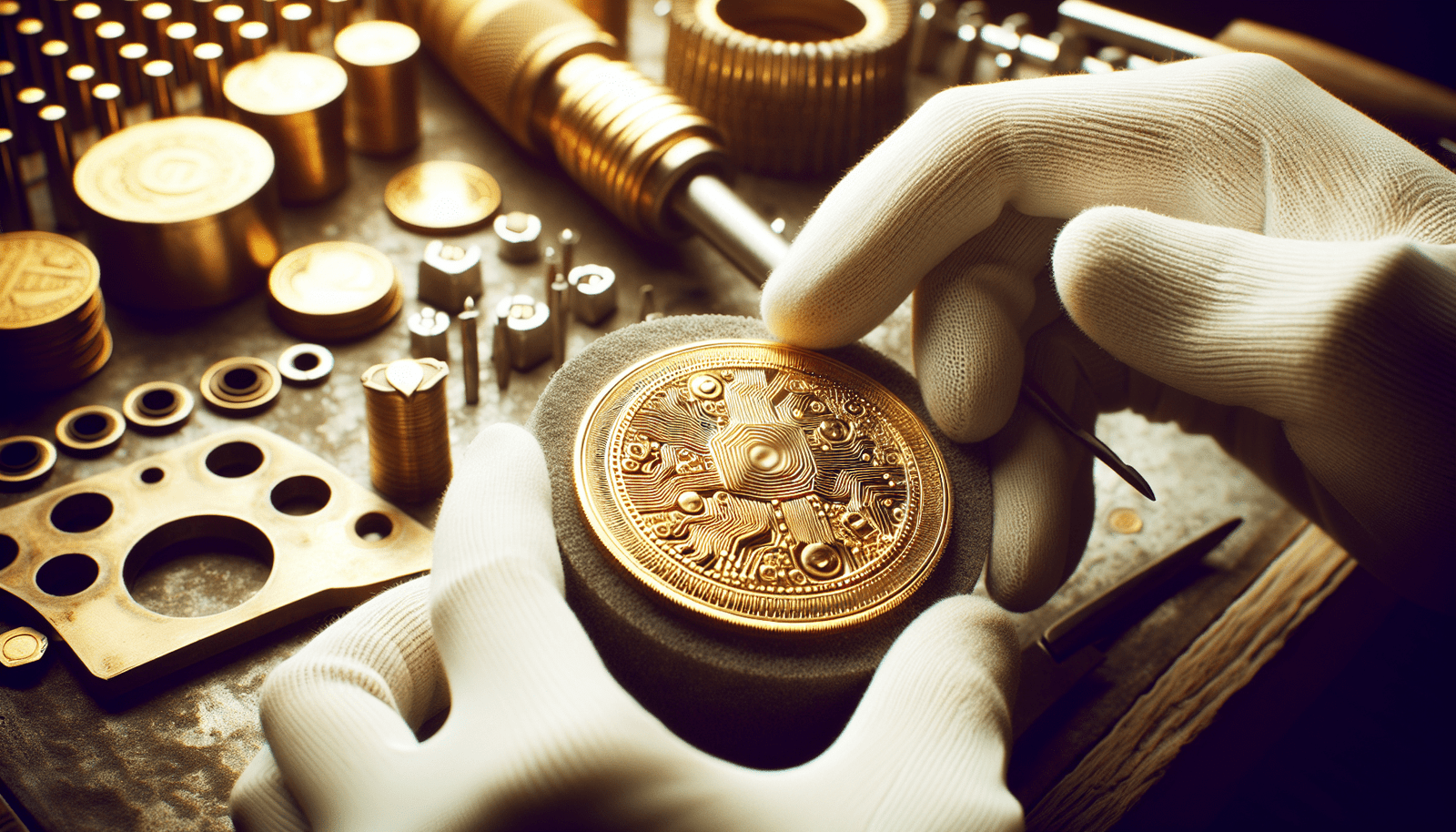Imagine being transported back in time to an era of intricate craftsmanship and timeless beauty. As you step into the world of gold coin minting, you are engulfed in a mesmerizing spectacle that combines artistry and precision. From the delicate engravings to the flawless finishing touches, the art and craft of gold coin minting unveils a fascinating history that has captivated generations. In this article, we will explore the intricate process behind creating these coveted treasures, delving into the skillful hands that bring history to life and showcasing the enduring allure of these golden works of art.

1. History of Gold Coin Minting
1.1 Ancient Origins
Gold coin minting has a rich history that dates back to ancient times. The earliest known gold coins were minted in Lydia, a region in modern-day Turkey, around 600 BC. These coins were made from a naturally occurring mixture of gold and silver called electrum. The concept of using coins as a form of currency quickly spread throughout the ancient world, as civilizations recognized the value and portability of gold.
1.2 Medieval Period
During the medieval period, gold coins played a vital role in trade and commerce. The Byzantine Empire, in particular, minted exquisite gold coins, such as the solidus, which featured intricate designs and served as a symbol of imperial power. Gold coins were also minted in other regions, including Europe and the Islamic world, reflecting the economic prosperity and cultural achievements of the time.
1.3 Renaissance Era
With the dawn of the Renaissance, gold coin minting became even more refined and artistic. European monarchs, such as Henry VII of England and Francis I of France, commissioned skilled engravers to create intricate designs for their gold coins. These coins often depicted the ruler’s portrait or emblem, symbolizing their authority and promoting their image. Gold coins from the Renaissance era are highly sought after by collectors and are admired for their historical and aesthetic value.
2. Gold Coin Design
2.1 Importance of Design
The design of a gold coin is of utmost importance as it not only enhances its aesthetic appeal but also serves as a potent symbol of its era and culture. A well-designed coin can capture the essence of a nation’s history, embody its values, and convey a sense of pride and identity. Therefore, extensive thought and creativity are put into the design process to ensure that each gold coin is a work of art in its own right.
2.2 Symbolism and Iconography
Gold coins often feature various symbols and iconography that hold significant meaning. These can include national emblems, historical figures, or religious symbols. For example, the American Gold Eagle coin showcases Lady Liberty on the obverse, symbolizing freedom and democracy, while the reverse features a bald eagle, a powerful symbol of strength and majesty. These symbols help to create a connection between the coin and its cultural heritage.
2.3 Elements of Design
The design of a gold coin encompasses various elements, including the layout, typography, and imagery. The layout refers to how different elements are arranged on the coin’s surface, ensuring a harmonious balance between the obverse and reverse. Typography involves the selection of appropriate fonts and sizes for inscriptions such as the coin’s denomination and country of issue. Lastly, imagery plays a crucial role in telling a visual story, whether it be through engraved portraits, landscapes, or intricate patterns.
3. Materials and Tools Used in Gold Coin Minting
3.1 Gold Alloy Composition
Gold coins are typically made from a gold alloy, which is a mixture of gold and other metals. The addition of alloying metals, such as copper or silver, enhances the coin’s durability and gives it the desired hardness and color. The gold alloy composition is carefully chosen to strike a balance between purity and practicality, ensuring that the coin retains its value while being resistant to wear and tear.
3.2 Coin Blanks and Planchets
To create a gold coin, a circular blank, also known as a planchet, is first cut from a sheet of gold alloy. The planchet is then meticulously weighed and inspected to ensure it meets the specifications of the intended coin. These blanks can vary in size and thickness, depending on the desired denomination and design of the coin.
3.3 Engraving Tools
Engraving tools are essential in the minting process as they allow intricate designs to be carved into the surface of the coin. Traditional engraving tools include a variety of chisels, graving tools, and punches. These tools are skillfully wielded by the mint’s engravers, who meticulously cut the design into the coin’s surface, ensuring every detail is accurately reproduced.

4. The Coin Minting Process
4.1 Design Creation
Before the minting process can begin, a design must be created for the gold coin. This involves a collaboration between artists, engravers, and mint officials. The design is typically sketched or digitally rendered, taking into consideration the coin’s specifications and desired aesthetic. Once the design is finalized, it serves as the blueprint for the production of the master die.
4.2 Master Die Creation
The master die is a hardened metal cylinder into which the coin’s design is engraved in relief. This is done using a specialized pantograph or cutting machine, which precisely replicates the original design onto the die. The master die is then used to create working dies, which will be used in the production of the actual coins.
4.3 Coin Production Steps
The production of gold coins involves several steps. First, the coin blanks are fed into a coin press, where the obverse and reverse designs are stamped onto the blank simultaneously. This process is known as striking. The struck coins are then inspected for quality and sorted according to their denomination. Finally, the coins are packaged and distributed to banks, collectors, or investors.
5. Minting Techniques
5.1 Hand-Striking
Hand-striking is one of the oldest minting techniques and requires immense skill and precision. In this method, each coin blank is individually placed between two dies, and a mint operator strikes the dies with a hammer or striking press. Hand-striking provides a unique aesthetic appeal as slight variations may occur during the process, resulting in subtle differences between each coin.
5.2 Machine-Striking
Machine-striking, also known as mechanical coinage, involves the use of high-speed coin presses. The coin blanks are mechanically fed into the press, which strikes them with great force, resulting in a consistent and uniform appearance. Machine-striking allows for the production of a large volume of coins in a shorter amount of time, making it the preferred method for mass production.
5.3 Proof Coin Minting
Proof coin minting is a special minting technique that produces coins of exceptional quality and detail. The process involves multiple strikes on specially polished blanks, resulting in a mirror-like surface and sharp relief. Proof coins are often characterized by their frosted designs and deeply mirrored fields, making them highly sought after by collectors and numismatists.
6. Quality Control and Authentication
6.1 Inspection and Verification
To ensure the authenticity and quality of gold coins, strict quality control measures are implemented during the minting process. Coins are randomly selected and inspected for weight, diameter, thickness, and overall appearance. This ensures that each coin meets the specified standards and is fit for circulation or collection.
6.2 Mint Markings
Mint markings, such as mintmarks and privy marks, are used to identify the mint that produced the coin. These markings can provide valuable information to collectors and help authenticate the coin’s origin. Additionally, mint markings can vary over time, making them a fascinating aspect of collecting and studying gold coins.
6.3 Professional Authentication
For high-value or rare gold coins, professional authentication by reputable grading services is often sought. These authentication services thoroughly examine the coin, assess its condition, and assign it a grade or certification. This process provides additional peace of mind to collectors and investors, as it guarantees the authenticity and value of the coin.
7. Collecting and Investing in Gold Coins
7.1 Numismatic Value
Gold coins have intrinsic value due to their gold content, but they can also possess significant numismatic value. Numismatic value is determined by factors such as rarity, historical significance, and condition. Collectors and investors often seek out gold coins with high numismatic value, as they can appreciate in price over time and provide a tangible link to history.
7.2 Rarity and Condition
The rarity and condition of a gold coin significantly impact its value. Coins with low mintage numbers or those in exceptional condition are considered more desirable and can command higher prices in the market. Rarity can be influenced by a variety of factors, including limited production runs, historical events, or errors during the minting process.
7.3 Long-Term Investment Potential
Gold coins have long been considered a reliable store of value and a hedge against inflation. As tangible assets, they offer stability and security, unlike paper currencies that can depreciate over time. Gold coins have a history of holding their value and have the potential to appreciate, making them a popular long-term investment choice for individuals looking to diversify their portfolios.
8. Famous Gold Coin Mints
8.1 United States Mint
The United States Mint, founded in 1792, is one of the most renowned mints in the world. It is responsible for producing iconic gold coins such as the American Gold Eagle and the Saint-Gaudens Double Eagle. The United States Mint is known for its exceptional craftsmanship and dedication to minting coins of unparalleled quality and beauty.
8.2 Royal Canadian Mint
The Royal Canadian Mint, established in 1908, is renowned for its high-quality gold coins. The mint produces the popular Canadian Gold Maple Leaf, which features a distinct maple leaf design and has a reputation for its purity and fine craftsmanship. The Royal Canadian Mint is recognized worldwide for its commitment to excellence in minting.
8.3 Perth Mint
The Perth Mint, located in Australia, has a long history of producing exceptional gold coins. Founded in 1899, it is known for its innovative designs, exceptional quality, and limited edition releases. The Perth Mint produces a range of gold coins, including the highly sought-after Australian Kangaroo and Lunar series, which depict iconic Australian wildlife.
9. Notable Gold Coin Designs
9.1 Saint-Gaudens Double Eagle
The Saint-Gaudens Double Eagle, designed by renowned sculptor Augustus Saint-Gaudens, is considered one of the most beautiful gold coins ever minted. Its obverse features a full-length figure of Lady Liberty holding a torch and an olive branch, while the reverse showcases a majestic flying eagle. The intricate details and artistry of the coin make it a favorite among collectors and enthusiasts.
9.2 Krugerrand
The Krugerrand, first minted in 1967, was the world’s first modern gold bullion coin. It features a portrait of Paul Kruger, the former President of South Africa, on the obverse and a springbok antelope on the reverse. The Krugerrand played a significant role in making gold ownership accessible to the public and remains an iconic gold coin for investors worldwide.
9.3 Britannia Gold Coin
The Britannia Gold Coin, first issued in 1987, is a symbol of British heritage and strength. The coin features a portrayal of Britannia, the female personification of Great Britain, on the reverse. The Britannia Gold Coin has become a popular choice for both collectors and investors, showcasing the rich history and tradition of the United Kingdom.
10. Care and Maintenance of Gold Coins
10.1 Proper Handling and Storage
To preserve the value and condition of gold coins, proper handling and storage are essential. It is recommended to handle gold coins with clean, dry hands to prevent oil or dirt from damaging the surface. Coins should be stored in airtight containers or protective cases, away from direct sunlight, extreme temperatures, and moisture.
10.2 Cleaning and Preservation
Gold coins should be cleaned sparingly, as excessive cleaning can damage their surfaces and reduce their value. If necessary, gentle cleaning can be done using warm water and mild soap. It is important to avoid abrasive materials or harsh chemicals that can scratch or tarnish the coin. Preservation can be enhanced by using archival-quality coin holders or capsules to protect against physical damage.
10.3 Avoiding Common Damages
To avoid common damages to gold coins, it is essential to avoid unnecessary handling and exposure to harsh environments. Avoid touching the surface of the coin, as oils and acids from the skin can leave tarnish marks. Additionally, avoid storing gold coins in areas prone to high humidity or fluctuating temperatures, as this can lead to corrosion or mold growth. Regular inspection and maintenance are key to ensuring the long-term preservation of gold coins.
Gold coin minting is not only a fascinating art form but also an important aspect of history, culture, and finance. From ancient origins to modern production techniques, the craft of minting gold coins continues to captivate collectors, investors, and enthusiasts worldwide. Whether admired for their aesthetic beauty, historical significance, or investment potential, gold coins continue to shine as timeless treasures.

